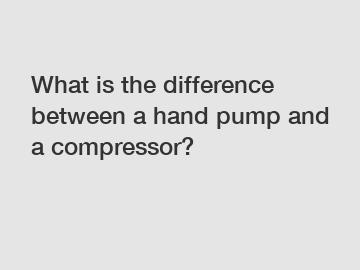What is the difference between a hand pump and a compressor?
What is the difference between a hand pump and a compressor?
When it comes to choosing between a hand pump and a compressor, understanding the differences between the two can be crucial in making an informed decision. A hand pump and a compressor are both mechanical devices used for transferring fluids or gases, but they operate in distinct ways and serve different purposes.
A hand pump is a manual device that relies on physical force to transfer fluid or gas from one place to another. It typically consists of a handle, a cylinder, and valves. The user applies force to the handle, causing the piston within the cylinder to move and create a pressure differential. This pressure differential allows the fluid or gas to be drawn into the cylinder and expelled through the outlet valve.

On the other hand, a compressor is a mechanical device that uses external power, typically electricity or an internal combustion engine, to increase the pressure of a fluid or gas. It works by drawing in the fluid or gas and then compressing it, leading to a significant increase in pressure. Compressors are commonly used in various industrial applications, such as powering tools and equipment, refrigeration systems, and even in the production of compressed air for pneumatic systems.
The key difference between a hand pump and a compressor lies in their operational efficiency, power source, and applications. Hand pumps are relatively simple and require manual effort as the power source. They are commonly used in situations where portability or electricity is not available, such as camping trips or remote agricultural areas. Hand pumps are capable of transferring fluids or gases, but their efficiency is limited compared to compressors. The manual operation also restricts the volume and pressure that can be achieved.
Compressors, on the other hand, offer higher efficiency and increased power due to their reliance on external power sources. They can handle larger volumes of fluid or gas and generate higher pressures, making them suitable for heavy-duty industrial applications where continuous high-pressure output is required. The ability to adjust the pressure output of a compressor also adds to its versatility, making it adaptable to a wide range of applications.
The difference between a hand pump and a compressor is not only limited to their operational characteristics but also extends to the impact they have on various industries and everyday life. The efficiency and power of compressors make them a crucial component in various sectors such as construction, manufacturing, and automotive. Their ability to generate high-pressure air or gas allows for the operation of pneumatic tools, powering heavy machinery, and maintaining safe and reliable refrigeration systems. In contrast, hand pumps are relied upon for simpler and more portable applications, often found in rural settings for tasks like well-water extraction or air inflation for recreational activities.
In conclusion, while a hand pump and a compressor share the common goal of transferring fluids or gases, their differences lie in their operational mechanisms, power sources, and applications. Hand pumps provide a simple and portable solution, relying on manual effort, while compressors offer higher efficiency and power through external power sources. Understanding these differences is crucial in selecting the right device for specific tasks or applications, ensuring optimal performance and efficiency.
Contact us to discuss your requirements of gx cs4, china gx-pump.com company, china gx pcp compressor factory. Our experienced sales team can help you identify the options that best suit your needs.
227
0
0

Comments
All Comments (0)